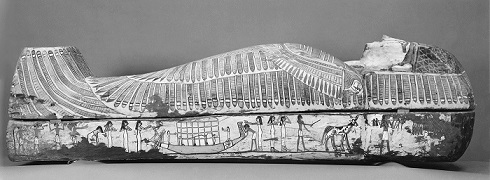Egyptian artisans of the New Kingdom used hair in their drawings for expressing body movements (dance, body bow…).
This technique, adopted from the way of drawing the professional mourners, was applied to the masculine figures in a respectful attitude. The front lock of hair forwards helped the Egyptian artist to represent the respectful bow in front of deities.
Later on, we find that this same practice was applied also to some femenine figures.
In the Papyrus of Anhai, which dates from XX Dynasty, the dead women was represented also bending her body to the goods, but her whole mane of hair is shaken forwards. The gesture remembers the one of the mourners covering their faces with their hair.

Papyrus of Anahi. the dead woman with her hair forwards and bending her body as a sign of respect. XX Dynasty. Photo: British Museum.
Obviously we are not facing here a mourning rite. The Egyptian artist took the tachnique from the mourning scenes and this way he could stress the gesture of respect of the dead women in front of the goods.
The point here is to see how this practice of the whole mane of hair forwards is applied in Egyptian art to a female figure. While for the dead men the front lock of hair was enough for stressing the respectful attitude. The idea that comes to our mind is that the hair forwards covering the face was in Egyptian art just a female gesture.

Book of the Dead of Henuttawy. XXI Dynasty. Photo: British Museum
The Book of the Dead of Henuttawy dates also from XXI Dynasty and shows Henuttawy adoring the rising sun . In this case the body gesture is not just respect, but reverence. She is completely on earth, kneeling and facing the ground, while many locks of hair are falling in front of her head. Here the Egyptian artist utilised this femenine resource of the disheveled hair falling forwards for stressing the reverential attitude of the woman.
Summin up, Egyptian artists used the hair for representing the mourning gestures of women in funerals. This technique was later also adopted in Egyptian art from the New kingdom to express some quotidian body movements (playing music, dancing, bending) and some attitudes related to them (respect and reverence).





